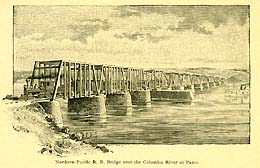On December 3, 1887, the Northern Pacific Railroad opens a temporary bridge across the Columbia River from Pasco in Franklin County to Kennewick in what is now Benton County. For the first time, transcontinental trains, which previously crossed the river by ferry, are able to run straight through to Tacoma via Stampede Pass. Part of the temporary bridge is soon swept away by winter ice, but it reopens in April 1888. A permanent bridge is in place by July 1888, marking final completion of the Northern Pacific Railroad.
The Northern Pacific had completed a transcontinental line from Minnesota to Eastern Washington by 1883. However, to reach Puget Sound, its trains had to use the tracks of the rival Oregon Railway & Navigation Company from the mouth of the Snake River down the Columbia River past Portland, Oregon, before before being barged across the Columbia to Kalama in Cowlitz County and continuing north to Tacoma. By 1881, the Northern Pacific was surveying a route for a Cascade Branch that would cross the Columbia near the mouth of the Snake, then follow the Yakima valley toward the Cascade Mountains, which it would cross at Stampede Pass.
An Engineering Challenge
Northern Pacific construction engineer J. T. Kingsbury concluded that the best place to cross the Columbia was four miles upriver from the Northern Pacific town of Ainsworth at the mouth of the Snake River. Since the existing track and town were four miles below the proposed crossing, the Northern Pacific built a new section of track to the crossing site, where it established the town of Pasco.
Trains were ferried by steamer across the Columbia to Kennewick on the west bank until the bridge could be constructed. Doing so was a major engineering challenge. At high water, the river at the crossing point was almost a half mile wide and 45 feet deep, with a current of up to seven miles per hour. The Northern Pacific’s finances were not strong, and the company opted against building a bridge with solid masonry piers and an all-iron superstructure. Instead, utilizing the timber that was abundant along its Cascade Branch line, the company designed a timber-and-iron superstructure resting on stone-filled crib piers of timber with nested-pile foundations. The bridge would consist of nine through-truss spans, five on the Pasco side and four on the Kennewick side, with a drawspan in the middle. The total length of the bridge was 2,587 feet.
Hoffman & Bates was awarded the bridge construction contract in early May 1887, but could not begin work until June, after high water. At the same time, L. C. Eaton was hired to cut the best fir timber in the Teanaway region of the eastern Cascades for use in the trusses. In October 1887 the "grillage" (multiple layers of 12 by 12 timbers) for the pier on which the drawspan would pivot was floated into the middle of the river, and masons began erecting the stonework for the pier on top of it. The plan was that as the pier was built, the grillage would gradually sink onto the piles placed below, but the timber was more buoyant than anticipated and instead of sinking, it became top heavy and overturned when hit by the wake of a passing steamer. All but one workman jumped to safety. Charles Ericson, who had a recent leg injury, could not jump in time and drowned.
First Through Trains
Despite the accident, construction pushed ahead. On December 3, 1887, the company declared the temporary bridge ready and trains began to cross on their way through to Tacoma. The bridge did not remain open long. Early in January 1888 ice swept away part of the bridge’s falsework. Then on January 18, 1888, workers using explosives to clear some of the ice that had built up on the Kennewick side let loose about an acre of ice which swept downriver and cut off the piers on either side of the drawspan. Three hundred feet of bridge sagged, hanging by the rails. Workers were able to remove the rails, but the roadbed fell into the river and was lost.
Not until April 1888 was the temporary bridge repaired and able to carry trains across the Columbia again. Work continued on the permanent bridge, and claimed two more lives on June 12, 1888, when two workers fell into the river from the bridge superstructure. The last span was put in place on July 14, 1888. Soon thereafter, the Columbia River bridge was completed. The Stampede Tunnel had opened to traffic on May 27, 1888, replacing a temporary track over the pass, so the bridge marked the final completion of the Cascade Branch and of the Northern Pacific’s transcontinental route.
The present day (2003) bridge at this location has been substantially rebuilt.

